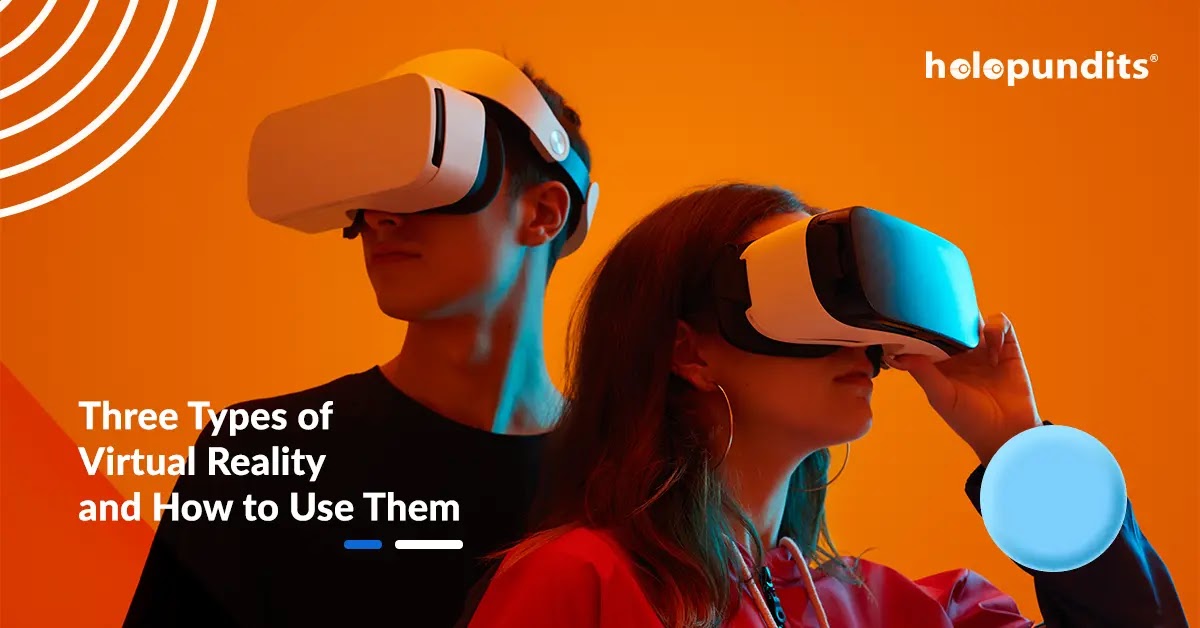Three Types of Virtual Reality and How to Use Them

What is Virtual Reality and How Does It Work
Virtual reality is one end of the XR or extended reality spectrum, where one end supplements the physical world with digital information (augmented reality) and the other (virtual reality) removes the physical world almost entirely. VR has four main elements that make it what it is: immersion into a virtual world that allows for sensory feedback and interactivity. Taking away any of these elements makes calling it virtual reality moot, with the most important being immersion in a virtual world.
Virtual reality is quite simple in explanation, though the mechanics of it can get quite complicated. Simply put, sensors on a headset, playing mat (a mat to stand on), or gloves take in motion stimuli and convert those movements into the virtual space in which a person is set, be it a game, training environment, or virtual meeting. The processor takes that information and transfers it into the headset, which orients the user into the space and allows them to interact with digital sounds, sights, and objects.
Virtual reality is a more immersive subset of extended reality, but not all virtual reality experiences are created the same. There are three types of virtual reality in regard to immersion levels- non-immersive, semi-immersive, and fully immersive. The level of engagement may change depending on the level of immersion. Even though a person can use virtual reality to any degree in any environment, there are specific scenarios in which a deeper or more shallow level of immersion would better suit. For instance, virtual reality can be anything from a user playing a video game on a PC (the virtual reality environment then being the game environment itself), to a soldier training battle tactics in a fully immersive virtual environment in which any outside stimuli are eliminated.
Non-Immersive Virtual Reality
Non-immersive virtual reality refers to technology that doesn't require any additional equipment to interact with. So, a television program in which the viewer gets to decide the fate of the main character, like Bear Grylls interactive Netflix show, You vs. Wild. It hold almost no real immersion into the video environment, yet the user still interacts and controls the way the character interacts with the environment. The same holds true for video games in which the player controls the character and the character interacts with the environment. This type of virtual reality doesn't need a headset, sensory gloves, or mat to use. Non-immersive reality has been used as a therapeutic tool for improving symptoms of disorders like Alzheimer's and Parkinson's by helping practice fine motor movements. In this scenario, the patient would use a joystick or other control to interact.
Semi-Immersive Virtual Reality
Semi-immersive virtual reality refers to experiences where the user does interact with a virtual environment with some senses (but not all) cut off, but is still completely aware of the physical environment around them. It does offer some aspect of a fully immersive VR experience, but not all. For instance, a flight simulation that enables the polit to practice flight maneuvers using head mounted displays while still being aware of their surroundings is a semi-immersive VR experience. In construction a contractor can use a head mounted display in order to walk around the physical building site and see the fully realized version of the project in real time before it's fully gone up. The contractor can walk around the site because they can still see what's really there, but the overlay of information shows a different image where necessary.
Fully Immersive Virtual Reality
Fully immersive virtual reality is the most extreme of the three and is just as it sounds- total immersion into a digital environment and a complete cut off of the physical world. In this instance, the user would have visual and audio stimuli coming from the headset. In some cases (like exposure therapy, or guided tours of in a museum) a physical representation of the environment that would mimic the movements of the virtual items they would be in contact with are added to the VR experience. This could include seats, objects, pools, and heated or cooled rooms. Water therapy for pain management for certain disorders with symptoms of nerve pain, like Fabry, or childbirth, could benefit from the use of virtual reality immersion to create a deeper non-sensory experience. Water therapy works by reducing inflammation and sharp physical stimuli. Adding a virtual reality (with waterproof equipment, of course) component to reduce or add audio and video simulations to the experience, could aid in the pain management aspects of water therapy.
Finding the Right Experience
There are many positive aspects to using virtual reality, and some negative. These negative attributes can be mitigated by ensuring the use of the right equipment for the job, so to speak. Fully immersive experiences often end early with the user experiencing lightheadedness, headaches, and nausea. This is especially prominent in gaming that requires rapid physical motion like running, jumping, or spinning. Using a fully immersive experience where a semi- or non- immersive experience could suffice would be overkill.
In some scenarios, the job only calls for a semi-immersive experience, like retail training where the trainee is given scenarios to work through, but not required to move around actively to complete the training. Using a fully immersive experience would not be necessary, and potentially less cost effective.
Instances in which a fully immersive experience would be necessary are exposure therapy, some VR games where the user intends to have that experience, and training where full immersion is necessary to test things like mental acuity and emotional preparedness for high pressure situations.
Extended reality is one of the biggest and fastest growing industries in the world, and virtual reality is at the forefront of development. People are beginning to realize the positive qualities of VR and utilize it in their daily lives, be it personal or business. With the tree types of virtual reality experiences, there is something out there for everybody. Gamers looking for a deeper gaming experience will find fully immersive virtual reality especially entertaining. Therapists looking for new ways to help patients work through their issues with greater understanding can find virtual reality a valuable tool. Educators and business trainers would benefit form VR's ability to teach and help users understand critical concepts in greater detail. Virtual reality is reshaping the way the world operates, one experience at a time.



Comments
Post a Comment